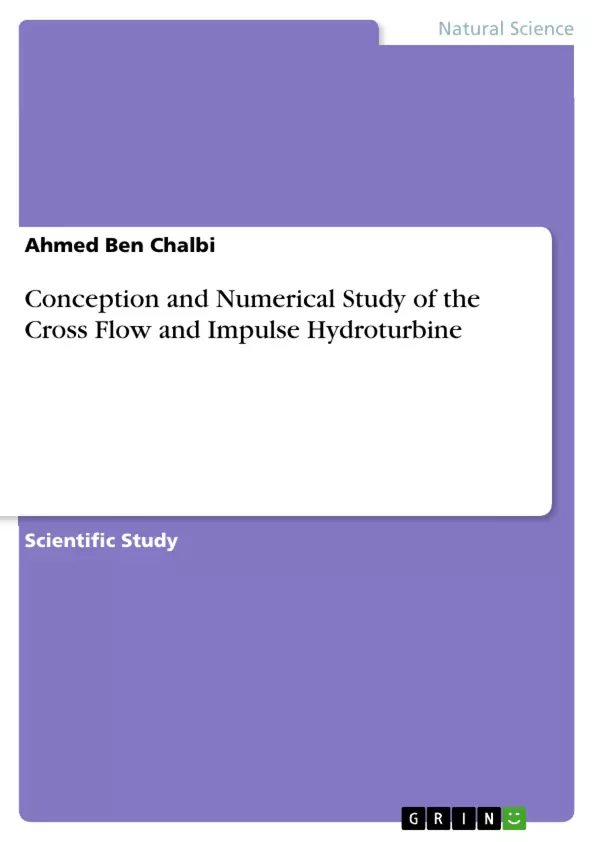Energy is one of the most major fields in the development of a society and its economy. Its consummations rate could by the way be an indicator of the level of prosperity that a nation could achieve. Among renewable sources of energies, hydro power is an important source of environmental-friendly energy and has become more and more important in the recent years. Water energy, as a renewable source of energy, can help in reducing the dependency on fossil fuels. The number of installed water power systems is increasing every year and many nations have made plans to make large investments in hydropower in the near future. Many developed and developing countries have realized the importance of water as an important resource for power generation and necessary measures are being taken up across the globe to tap this energy for its effective utilization in power production. Remarkable advances in water turbines design have been possible due to developments in modern technology. In this context, we are interested in developing a design and a numerical study of the Impulse and the Cross flow hydro turbine‘s type. This book contains four chapters; in the first, a bibliographic study has been developed in order to present a general view about renewable energy, hydropower and different ways to gather it. A particular interest has been given to the water rotors concerning their different types and historical of some famous type like cross flow and Impulse turbines type, object of our study. Indeed, the bibliographic study summarized the considered parameters to improve the water turbine performances. The second chapter presents the numerical approach developed using the CFD code "CFX". I present also the mathematical formulation and the turbulence model will be presented. Then a background of the used methods in our numerical model will be undertaken. The third chapter presents the numerical simulations consisting on the characterization of the hydro dynamic structure of the impulse and the cross flow turbines The fourth chapter consist of the design of the test bench and the different components and solutions.
Inhaltsverzeichnis (Table of Contents)
- Introduction
- Definition and working principle of the impulse and cross flow hydro-turbine
- Introduction
- The impulse turbine
- The cross flow turbine
- Numerical modeling of the impulse and cross flow hydro-turbine
- Introduction
- Governing equations
- Turbulence models
- Mesh generation and boundary conditions
- Numerical solution
- Results and discussion
- Introduction
- Impact of the design parameters on the turbine performance
- Performance comparison between the impulse and cross flow turbines
- Conclusion
Zielsetzung und Themenschwerpunkte (Objectives and Key Themes)
This project aims to design and numerically study the performance of an impulse and cross flow hydro-turbine. The study focuses on understanding the impact of various design parameters on the turbine's efficiency and power output. The project utilizes computational fluid dynamics (CFD) simulations to analyze the flow behavior and predict the turbine's performance.
- Design and numerical analysis of an impulse and cross flow hydro-turbine
- Impact of design parameters on turbine performance
- Performance comparison between impulse and cross flow turbines
- Application of computational fluid dynamics (CFD) for turbine analysis
- Evaluation of turbine efficiency and power output
Zusammenfassung der Kapitel (Chapter Summaries)
- Introduction: This chapter provides a brief overview of the project's objectives, the importance of hydro-turbines in energy production, and the motivation behind the research. It also presents a general background on the different types of hydro-turbines.
- Definition and working principle of the impulse and cross flow hydro-turbine: This chapter explains the design and working principle of the impulse and cross flow hydro-turbines in detail. It discusses the key components, flow dynamics, and the energy conversion process within each turbine type.
- Numerical modeling of the impulse and cross flow hydro-turbine: This chapter delves into the numerical methods used to model the turbine's performance. It explains the governing equations of fluid flow, the chosen turbulence models, and the process of mesh generation and boundary condition definition. It also discusses the numerical solution methods employed in the simulations.
- Results and discussion: This chapter presents the results of the numerical simulations, focusing on the impact of different design parameters on turbine performance. It analyzes the flow characteristics, efficiency, and power output of the turbine based on the simulation data. The chapter also compares the performance of the impulse and cross flow turbines under various operating conditions.
Schlüsselwörter (Keywords)
The study focuses on key terms and concepts related to hydro-turbine design, numerical modeling, and performance analysis. These include impulse turbines, cross flow turbines, computational fluid dynamics (CFD), turbine efficiency, power output, design parameters, flow dynamics, turbulence models, and numerical simulations.
- Quote paper
- Ahmed Ben Chalbi (Author), 2018, Conception and Numerical Study of the Cross Flow and Impulse Hydroturbine, Munich, GRIN Verlag, https://www.hausarbeiten.de/document/441047


